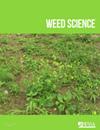杂草造成的早季甜菜产量损失中避荫和资源竞争的相对作用
IF 2.1
2区 农林科学
Q2 AGRONOMY
引用次数: 0
摘要
遮荫会改变植物的生长方式,通常会使植物长得更高,但却要牺牲叶子、根、种子和其他可收获材料的资源。甜菜(Beta vulgaris L.)是一种莲座期形成的二年生物种,在生长的第一年长高的能力有限。在作物-杂草竞争的背景下,相对于资源竞争等其他影响,避阴对甜菜产量的降低程度大多不得而知。为了确定在田间相关情况下避荫造成的产量损失程度,在一项田间研究中,甜菜与肯塔基蓝草(Poa pratensis L.)草皮一起生长。在禾本科植物和甜菜之间的地面上放置了一个钢制根部屏障,将根部隔开。四种处理包括无杂草对照(无根障或草)、根障对照(有根障但无草)、避荫处理(有根障和草)和完全竞争处理(有草但无根障)。无论是否有根障,草的存在与否都是影响甜菜生长和产量参数的主要因素。叶片数量和根系长度也受根系屏障的影响。这些结果表明,在早季甜菜因杂草而减产的情况下,避阴至少与根系相互作用和资源耗竭同样重要。本文章由计算机程序翻译,如有差异,请以英文原文为准。
Relative Contribution of Shade Avoidance and Resource Competition to Early-Season Sugar Beet Yield Loss Due to Weeds
Shade avoidance alters the way plants grow, usually causing them to grow taller at the expense of placing resources into leaves, roots, seeds, and other harvestable materials. Sugar beet (Beta vulgaris L.) is a rosette-forming biennial species that has limited capacity to grow tall in the first year of growth. In the context of crop-weed competition, it is mostly unknown to what extent shade avoidance reduces yield in sugar beet relative to other effects like resource competition. To determine the extent of yield loss due to shade avoidance in a field-relevant situation, sugar beets were grown alongside Kentucky bluegrass (Poa pratensis L.) sod in a field study. Roots were separated with a steel root barrier placed into the ground between the grass and beets. Four treatments included a weed free control (no root barrier or grass), a root barrier control (with root barrier but no grass), shade avoidance (with root barrier and grass), and full competition (with grass but no root barrier). The presence vs absence of grass was the primary driver of effects on measured sugar beet growth and yield parameters, regardless of whether a root barrier was present. Leaf number and root length were also impacted by the presence of the root barrier. These results suggest that shade avoidance is at least as important as root interactions and resource depletion in the context of early-season sugar beet yield loss due to weeds.
求助全文
通过发布文献求助,成功后即可免费获取论文全文。
去求助
来源期刊

Weed Science
农林科学-农艺学
CiteScore
4.60
自引率
12.00%
发文量
64
审稿时长
12-24 weeks
期刊介绍:
Weed Science publishes original research and scholarship in the form of peer-reviewed articles focused on fundamental research directly related to all aspects of weed science in agricultural systems. Topics for Weed Science include:
- the biology and ecology of weeds in agricultural, forestry, aquatic, turf, recreational, rights-of-way and other settings, genetics of weeds
- herbicide resistance, chemistry, biochemistry, physiology and molecular action of herbicides and plant growth regulators used to manage undesirable vegetation
- ecology of cropping and other agricultural systems as they relate to weed management
- biological and ecological aspects of weed control tools including biological agents, and herbicide resistant crops
- effect of weed management on soil, air and water.
 求助内容:
求助内容: 应助结果提醒方式:
应助结果提醒方式:


